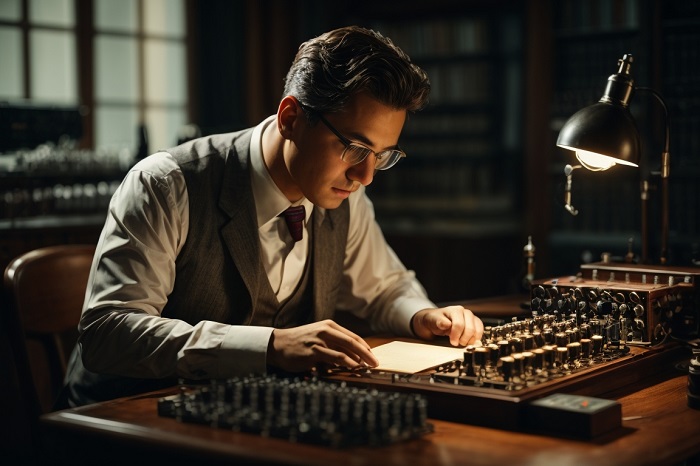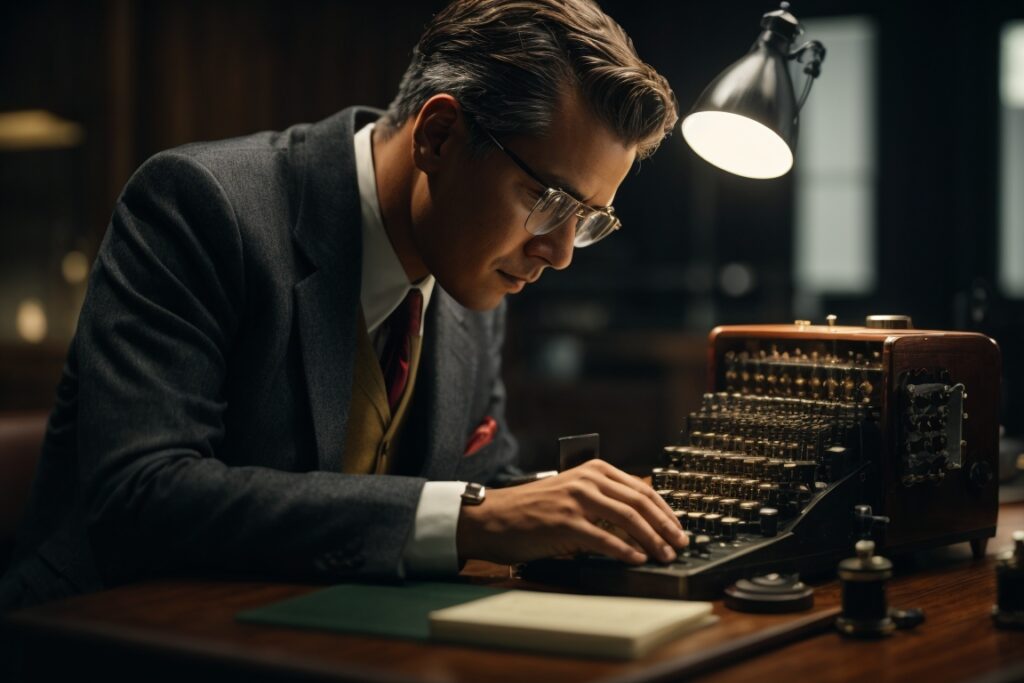
In the tapestry of human history, one thread stands out—an intricate weave of secrets, mysteries, and the relentless pursuit of secure communication. Our journey through the epochs of cryptography commences not in the distant past, but in the clandestine corridors of ancient civilizations. From the ciphered scrolls of Caesar’s Rome to the encrypted missives of Persian courts, the art of concealment was an age-old dance.
As we traverse the medieval landscape, witness the evolution of encryption from quill and parchment to the polished courts where coded letters held the keys to power. The Middle Ages unveil a cryptic realm where information became both a weapon and a shield, each encoded message concealing a strategic advantage.
Fast forward to the 20th century, where the Enigma machine emerges—a cryptographic marvel birthed by German engineer Arthur Scherbius. The Enigma, with its labyrinthine design, became the linchpin of covert communication during World War II, altering the course of history. But what lies beneath the surface of this enigmatic tale?
Table of Contents
Why Enigma Machine Invention Is Important?
The invention of the Enigma machine holds paramount importance in the realms of cryptography, military strategy, and technological innovation. Here are several key reasons why the creation of the Enigma machine is considered historically significant:
- Revolution in Secure Communication:
- The Enigma machine revolutionized secure communication, providing the German military with a highly sophisticated and seemingly unbreakable encryption tool. It marked a significant leap forward in the technological landscape of secret communication during the early to mid-20th century.
- Military Significance in World War II:
- During World War II, the Enigma machine became the primary cipher device for the German Army, Air Force, and Navy. Its adoption by various branches of the Axis powers, including Italy and Japan, underscored its central role in Axis military communication.
- Cipher Strength and Complexity:
- The Enigma’s cipher strength lay in its complexity. The machine’s intricate system of rotors, plugboards, and reflectors created an enormous number of potential cipher combinations. This complexity, coupled with the regular changes in its settings, initially gave the impression of an impregnable code.
- Codebreaking Challenge and Allied Success:
- The Enigma presented a formidable challenge to Allied codebreakers, leading to a dynamic and intense intellectual battle. The successful efforts to decipher Enigma-encrypted messages, spearheaded by individuals like Alan Turing at Bletchley Park, provided the Allies with invaluable military intelligence.
- Innovation in Codebreaking Techniques:
- The Enigma machine prompted innovation in codebreaking techniques. Collaborative efforts involving mathematicians, cryptanalysts, and engineers resulted in the development of specialized machines like the Bombe. This laid the groundwork for future advancements in computing and cryptography.
- Turning Point in Cryptography:
- The breaking of the Enigma code marked a turning point in the history of cryptography. It demonstrated that even the most complex encryption systems could be deciphered with innovation, collaboration, and perseverance. This realization had profound implications for the future of codebreaking and cryptography.
- Secrecy and Espionage:
- The secrecy surrounding the Enigma codebreaking effort, known as Ultra intelligence, had significant strategic implications. By keeping the success of Allied codebreakers confidential, the Allies maintained a critical advantage in military strategy and espionage.
- Legacy and Symbolism:
- The Enigma machine’s legacy extends beyond its wartime significance. It remains a symbol of the perpetual struggle between cryptography and codebreaking, highlighting the ceaseless evolution of technology and the indomitable human spirit in the face of formidable challenges.
In essence, the invention of the Enigma machine represents a pivotal moment where technology, war, and intelligence intersected. Its impact on military communication, the development of codebreaking techniques, and the broader narrative of cryptography make the Enigma a crucial chapter in the annals of history. Understanding its importance provides insights into the delicate balance between encryption and decryption that continues to shape our interconnected world.
Who Invented the Enigma Machine?

The Enigma machine was invented by German engineer Arthur Scherbius in the early 20th century. Introduced in the 1920s, the Enigma became synonymous with covert communication during World War II. Scherbius designed this encryption device with the primary goal of securing sensitive information. The machine underwent several modifications, creating a complex system of rotors and plugs that scrambled messages. Its intricate design made it a formidable challenge for codebreakers, contributing to its widespread use by the German military. The Enigma machine’s inventor, Scherbius, likely never anticipated the pivotal role it would play in the history of cryptography and intelligence during wartime.
What is the Enigma Machine?
The Enigma machine, a groundbreaking invention attributed to German engineer Arthur Scherbius, stands as a remarkable artifact from World War II, wielding immense significance in the realm of military cryptography. This electro-mechanical device, resembling a typewriter but concealing a labyrinth of complexity within, was designed for one primary purpose – secure communication.
Arthur Scherbius crafted the Enigma machine as a tool to encrypt sensitive messages, providing the German military with a seemingly impenetrable code. Its intricate system involved rotors, plugs, and a typewriter-like interface, allowing operators to input a message that would then undergo a complex transformation into a ciphered text. The recipient, possessing an Enigma machine configured with identical settings, could decrypt and reveal the original message.
During its heyday, the Enigma machine played a pivotal role in German communication strategy, enabling the transmission of critical information with confidence in its security. The brilliance of the Enigma lay in its capacity to generate an astronomical number of potential cipher combinations, presenting an almost insurmountable challenge for would-be codebreakers.
However, the very complexity that shrouded the Enigma also became its vulnerability. The Allied forces, recognizing the strategic importance of decrypting Enigma-encoded messages, initiated concerted efforts to unravel its secrets. This endeavor was led by brilliant minds like Alan Turing, whose pioneering work in breaking the Enigma code significantly influenced the course of the war.
The Enigma saga, therefore, encompasses not just the story of a machine but a battle of wits and innovation. The relentless pursuit to decode its messages symbolizes the power of human intellect against formidable technological barriers. The breakthroughs achieved in Enigma decryption marked a turning point in World War II and showcased the pivotal role of intelligence in shaping historical outcomes.
The legacy of the Enigma machine extends beyond its wartime significance. It remains an enduring symbol of the perpetual struggle between cryptography and codebreaking, a testament to the enduring quest for secure communication and the ceaseless evolution of technology.
In conclusion, the Enigma machine stands as an iconic symbol of cryptography, war, and the indomitable human spirit. Its invention, purpose, and ultimate decryption by Allied forces underscore the dynamic interplay between technology, intelligence, and historical events.
How Did the Enigma Machine Work?
The Enigma machine, a marvel of engineering and cryptography, operated through a complex mechanism that transformed plain text into a seemingly unbreakable cipher. Understanding how the Enigma machine worked involves unraveling the intricacies of its internal components and cryptographic processes.
At its core, the Enigma machine comprised rotors, a plugboard, and a reflector. The rotors, typically three or four in number, were cylindrical wheels with electrical contacts on each side. Each rotor had 26 electrical contacts, representing the letters of the alphabet. These rotors could be set in different positions, creating an astronomical number of possible combinations.
Operators would start by selecting the initial rotor positions, which determined the starting configuration of the machine. They would then choose a daily key, a set of rotor and plugboard settings shared among the intended message recipients. This daily key was changed every 24 hours, adding an extra layer of complexity to the encryption.
As an operator typed a message on the Enigma machine’s keyboard, an electrical current passed through the selected rotors, reflecting off the plugboard and finally reaching the reflector. The reflector ensured that the electrical signal, after passing through the rotors, was redirected back through a different path. This intricate process resulted in the encryption of each letter, transforming it into a seemingly random character.
The brilliance of the Enigma lay in its ability to change its settings with each key press, making it exceptionally challenging to crack the code. The number of potential combinations was astronomical, with 158,962,555,217,826,360,000 possibilities, providing an illusion of impregnability.
To decrypt a message, the recipient needed an Enigma machine configured with the exact settings used by the sender. This process required precise synchronization of rotor positions and plugboard connections. The challenge for codebreakers was not just the complexity of the system but the daily change in key settings.
The Allies, led by codebreakers like Alan Turing at Bletchley Park, employed innovative methods to decipher Enigma-encrypted messages. Turing’s invention of the Bombe machine, designed to automate the decryption process, played a pivotal role in unraveling the Enigma code and turning the tide of World War II.
In essence, the Enigma machine’s operational principle was a delicate dance of rotors, plugboards, and reflectors, creating a cryptic ballet that, at the time, seemed impervious to decryption but ultimately succumbed to human ingenuity and perseverance.
Who Broke the Code of the Enigma Machine?

The Enigma code was successfully broken through collaborative efforts involving various individuals and teams. One of the key contributors was the Polish Cipher Bureau, particularly mathematicians Marian Rejewski, Jerzy Różycki, and Henryk Zygalski. In the early 1930s, they made significant progress in deciphering Enigma-encrypted messages and developed the “Bomba,” a device capable of identifying daily Enigma settings.
However, as the Germans enhanced the complexity of the Enigma machine, the Polish Cipher Bureau’s methods became less effective. When Poland fell to the Germans in 1939, the Polish mathematicians shared their findings and the Bomba with British and French intelligence.
The task of breaking the Enigma code was further advanced by British mathematician and logician Alan Turing, who played a pivotal role during World War II. Turing, along with a team of cryptanalysts at Bletchley Park, built upon the Polish achievements. Turing’s development of the Bombe, an electro-mechanical device inspired by the Polish Bomba, significantly expedited the decryption process.
Turing’s Bombe, combined with the collaborative efforts of a diverse group of experts at Bletchley Park, successfully deciphered Enigma-encrypted messages. The breakthroughs made by the Polish Cipher Bureau and the subsequent innovations by Turing and his team played a crucial role in Allied intelligence and significantly influenced the course of World War II. The collaborative efforts of multiple individuals from different nations and backgrounds contributed to the ultimate success in breaking the code of the Enigma machine.
How Did Alan Turing Crack the Enigma Machine?
Alan Turing’s contribution to breaking the Enigma code involved innovative thinking, mathematical prowess, and the development of a groundbreaking machine. Here’s a detailed explanation:
- Understanding the Enigma Machine: Turing began by studying the intricacies of the Enigma machine, a complex electro-mechanical device used by the Germans to encrypt their communications. The Enigma machine consisted of a series of rotating wheels (rotors) with electrical connections, creating a complex substitution cipher for each typed letter.
- Exploiting Weaknesses: Turing and his team at Bletchley Park understood that the Enigma had inherent weaknesses. The machine encrypted a letter differently each time it was pressed, but there were certain patterns and limitations due to operator habits and machine characteristics.
- The Bombe Machine: Turing, inspired by the Polish Bomba, conceptualized and developed the Bombe—a specialized electro-mechanical device designed to expedite the decryption process. The Bombe was engineered to search for possible rotor settings that could decrypt the intercepted messages.
- Brute Force Approach: The Bombe employed a brute force approach, systematically testing possible Enigma settings until the correct configuration was found. It eliminated unlikely settings and dramatically reduced the search space, making it feasible to decipher messages within a reasonable time frame.
- Daily Key Settings: The Germans changed the Enigma settings daily, complicating the decryption process. However, Turing’s team devised methods to predict the daily key settings based on patterns and intelligence gathered from various sources, further streamlining the decryption efforts.
- Collaborative Efforts: Turing’s work was part of a collaborative endeavor at Bletchley Park. Cryptanalysts, engineers, and linguists worked together, sharing insights and expertise. The collaborative environment was crucial in tackling the evolving challenges posed by the Enigma machine.
- Secrecy and Impact: The success of Turing and his team in breaking the Enigma code remained a closely guarded secret for many years. The intelligence gathered through decrypted messages provided invaluable information to the Allies, impacting military strategies and significantly contributing to the outcome of World War II.
In summary, Alan Turing’s approach involved a deep understanding of the Enigma machine, the development of specialized machinery (the Bombe), and a collaborative effort that combined the skills of experts from various fields. Turing’s groundbreaking work in cryptography and computing laid the foundation for modern computer science.
When Was the Enigma Machine Invented?

The Enigma machine underwent a series of developments and improvements from its initial invention to enhance its security features and capabilities. Here is a summary of the key stages in the evolution of the Enigma machine:
- Invention (1920): The Enigma machine was invented by German engineer Arthur Scherbius in the early 1920s. The first commercial model, known as Enigma A, was introduced in 1923. This early version had three rotors and a plugboard, but its cryptographic design had vulnerabilities.
- Military Adoption (1926-1930s): The German military recognized the potential of the Enigma machine for secure communication and adopted it for military use. The military versions (Enigma I) had additional security features, including the use of more rotors and a reflector, making it more complex than the commercial models.
- Increased Complexity (1930s): As the German military became aware of the need for stronger encryption, they introduced more rotors and a plugboard to increase the complexity of the Enigma machine. This made cryptanalysis more challenging for potential adversaries.
- Polish Codebreakers (1930s): In the early 1930s, Polish mathematicians and codebreakers, including Marian Rejewski, made significant breakthroughs in decrypting Enigma-encrypted messages. They developed techniques and built replicas of the Enigma machine, providing valuable insights into its functioning.
- German Response (1938-1939): In response to the Polish codebreaking efforts, the Germans made further modifications to the Enigma machine. They added additional rotors (IV and V) and changed operating procedures. These modifications increased the number of possible settings and made it more challenging for codebreakers.
- Polish-British Collaboration (1939): As World War II approached, the Polish codebreakers shared their Enigma decryption achievements with the British. The collaboration included the exchange of knowledge and the sharing of a replica Enigma machine. This collaboration laid the foundation for the codebreaking efforts at Bletchley Park.
- Bletchley Park (1939-1945): Bletchley Park, the British codebreaking center, played a crucial role in breaking Enigma-encrypted messages during World War II. Mathematicians and engineers, including Alan Turing, developed the Bombe, an electromechanical device designed to decipher Enigma settings. The British also made advancements in deciphering the more complex naval Enigma machines.
- German Countermeasures (1940s): Throughout the war, the Germans introduced various countermeasures to enhance the security of the Enigma machine. These included additional rotors, changes to reflector configurations, and the introduction of the Enigma Uhr, a device for altering plugboard connections.
- Allied Success (1940s): Despite German efforts to improve the Enigma’s security, Allied codebreakers, particularly at Bletchley Park, continued to make advancements. The introduction of the American Bombes and breakthroughs in deciphering the more complex naval Enigma machines contributed to the Allies’ success in reading encrypted messages.
- Post-War Developments (1950s Onward): After World War II, the use of the Enigma machine declined. The knowledge gained from codebreaking efforts remained classified for many years. New cryptographic technologies, such as electronic cipher machines, replaced the Enigma. The Enigma’s historical significance was acknowledged, and surviving machines became sought-after artifacts.
The continuous cycle of improvements, codebreaking efforts, and countermeasures during World War II significantly influenced the history of cryptography and intelligence. The Enigma story remains a fascinating chapter in the evolution of cryptographic technology.
What Was the Flaw in the Enigma Machine?
The flaw in the Enigma machine’s security lay in its encryption process, particularly in how it handled repeated letters in a message. The Enigma machine, despite its seemingly complex design, had a fundamental characteristic: a letter could not be encrypted as itself.
This meant that if a message contained a repeated letter, the encrypted version would not show the same repetition. Cryptanalysts at Bletchley Park exploited this weakness. They used known or guessed portions of the plaintext (cribs) and identified patterns that resulted from repeated letters in the original message.
Moreover, the Allies benefited significantly from Polish codebreakers who, in the early stages, provided critical information and a replica of the Enigma machine. The Polish Cipher Bureau, led by Marian Rejewski, used mathematical methods to deduce the Enigma’s wiring and developed techniques for breaking its encryption. The knowledge and techniques shared by the Poles played a crucial role when the British continued the codebreaking efforts at Bletchley Park during World War II.
In essence, the Enigma’s flaw allowed the codebreakers to discover patterns and relationships within the encrypted messages, contributing to the eventual deciphering of Enigma-encrypted communications.
How Many Enigma Machines Were Made?
The exact number of Enigma machines produced is challenging to determine precisely due to wartime secrecy and the destruction of records. However, it’s estimated that tens of thousands of Enigma machines were manufactured during World War II. Here are some key points related to the production of Enigma machines:
- Commercial Production (1920s-1930s): The Enigma machine was initially developed for commercial purposes by German engineer Arthur Scherbius in the early 1920s. The commercial models, such as Enigma A, were produced for business and personal use.
- Military Adoption (1930s): The German military recognized the potential of the Enigma machine for secure communication and adopted it for military use. The military versions, known as Enigma I, were produced and distributed to various branches of the German armed forces.
- Modifications and Variants: As the war progressed, the Germans introduced modifications to the Enigma machines to enhance security. These modifications included additional rotors, changes in rotor wirings, and the introduction of different reflectors. Specialized variants, such as the Enigma M3 and M4 for the navy, were also produced.
- Allied Capture and Destruction: As Allied forces advanced and captured German territories, they seized Enigma machines. To prevent the machines from falling into enemy hands, the Germans often attempted to destroy them. However, some machines were captured intact, providing valuable insights for Allied codebreakers.
- Post-War Use and Preservation: After World War II, some Enigma machines were used by various countries for a period, especially those unaware of the wartime codebreaking efforts. Over time, Enigma machines gained historical significance, and surviving units became sought-after artifacts. Museums, collectors, and institutions acquired many machines for preservation.
Given the widespread use of Enigma machines across different branches of the German military and their distribution to various locations, it’s challenging to pinpoint the exact number manufactured. The estimate of tens of thousands reflects the scale of production to meet the communication needs of the German armed forces during the war.
Can I Buy an Enigma Machine?

Yes, it is possible to buy Enigma machines today, but there are a few important considerations:
- Authenticity: Authentic World War II-era Enigma machines are rare and can be expensive. Ensure that the machine being offered for sale comes with appropriate documentation and provenance to confirm its authenticity.
- Condition: The condition of the machine is a crucial factor. Some machines may have been well-preserved, while others may require restoration. Understand the condition of the machine and whether it has been modified or restored.
- Legal Considerations: Check the legal aspects of purchasing and owning an Enigma machine. Some countries may have restrictions on the sale and ownership of historical cryptographic equipment.
- Source: Purchase from reputable dealers or auction houses specializing in historical artifacts. Be cautious of private sales without proper documentation or authentication.
- Cost: Authentic Enigma machines can be quite expensive due to their historical significance. Prices can vary widely based on factors such as model, condition, and provenance.
- Replicas: If owning a genuine Enigma machine is beyond your budget, there are also Enigma replicas available. These replicas are not original wartime machines but are functional reproductions that can provide a similar experience.
Before making a purchase, thoroughly research the seller, ask questions about the machine’s history, and ensure that you are complying with any legal requirements in your location.

Conclusion:
In the tapestry of history, the Enigma machine emerges not only as a symbol of wartime intrigue but as a testament to the indomitable spirit of human ingenuity.
From its inception by Arthur Scherbius to the relentless codebreaking efforts led by figures like Alan Turing, the Enigma saga encapsulates a battle of wits, innovation, and the pursuit of secure communication.
As we journeyed through the evolution of encryption—from ancient civilizations to the digital age—we witnessed the ever-changing landscape of secrecy and the enduring human quest for protection in the exchange of information. Knowing the Enigma is not merely a historical exploration but a recognition of the pivotal role cryptography plays in shaping the course of human events. The Enigma machine, with its flaws and triumphs, stands as a beacon, urging us to understand our cryptographic heritage, navigate the complexities of our digital present, and, above all, appreciate the timeless importance of securing the secrets that define our shared history.
